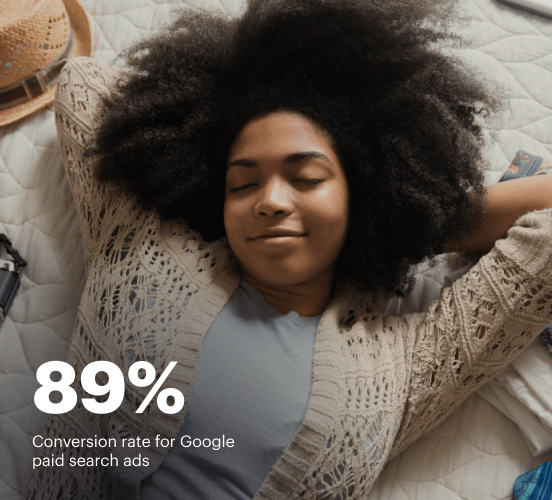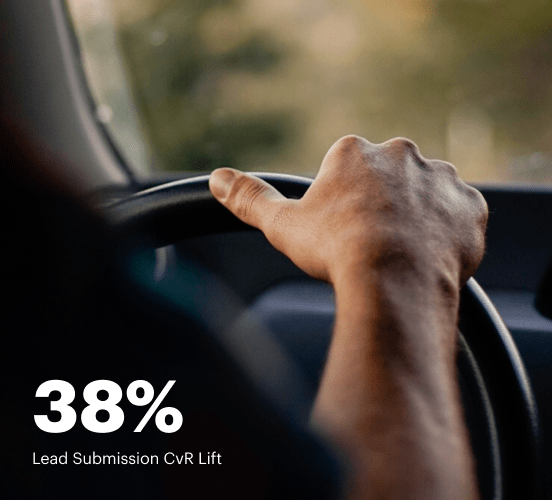How Webflow vs. Pardot vs. Instapage stack up against each other
Compare Instapage with Webflow and Pardot to create high-converting landing pages. With personalization, optimization, and collaboration tools, Instapage helps you deliver experiences that drive results.
Get startedSee how Instapage stacks up against the competition
| Feature | Instapage | Other builders |
| Drag-and-Drop Tools | ||
| Conversion-optimized templates | ||
| Manual and AI-powered A/B Tests | ||
| AI content suggestions | ||
| Popups and sticky bars | ||
| Canvas and grid blocks | ||
| Reusable and global elements | ||
| Form and popup builders | ||
| Built-in Heatmaps | ||
| Central analytics dashboard | ||
| Ad-to-page personalization and collections | ||
| Contacts, lists, and email | ||
| Dedicated, full-service CRO experts | ||
| Enterprise-ready platform |
Leading the way in building high-performing landing pages





Why Instapage is the smarter choice for your campaigns
Get everything you need to build, scale, and optimize high-converting landing pages—without coding.

Easier page building without coding
Instapage offers a flexible and seamless page creation experience with a library of 500+ conversion-focused layouts, Instablocks®, a drag-and-drop builder, and AI content generation. With technologies like Thor Render Engine®, you can create on-brand, mobile-responsive landing pages that load quickly and start converting during initial visitor clicks.

More insights — better results
Instapage lets you see in detail how each landing page experience and variation is performing so you can make targeted changes that boost page conversions. Use heatmaps for a better understanding of on-page activities, run A/B tests and AI-assisted experiments, and then track and evaluate results within robust analytics dashboards.

More personalized experiences
Instapage lets you quickly create high-performing landing pages tailored to each of your ad campaigns. Deliver personalized experiences for distinct audiences using dynamic text replacement. Effortlessly align specific advertisements to unique pages with AdMaps. Monitor audience-level metrics using our advanced data tools.

Built-in collaboration
Instapage collaboration capabilities bring your entire team together to speed up the process of landing page review, approval, and launch. No more frustrating and unnecessary revisions or edits scattered across emails. Provide instant feedback, conduct real-time page edits, and securely share your pages with outside stakeholders.

Free up time for your business
Invest time into business growth, not busy work. Launch landing pages faster with reusable forms and templates. Build once, reuse forever.
Explore all integrations






Easier page building without coding
Instapage offers a flexible and seamless page creation experience with a library of 500+ conversion-focused layouts, Instablocks®, a drag-and-drop builder, and AI content generation. With technologies like Thor Render Engine®, you can create on-brand, mobile-responsive landing pages that load quickly and start converting during initial visitor clicks.
More insights — better results
Instapage lets you see in detail how each landing page experience and variation is performing so you can make targeted changes that boost page conversions. Use heatmaps for a better understanding of on-page activities, run A/B tests and AI-assisted experiments, and then track and evaluate results within robust analytics dashboards.
More personalized experiences
Instapage lets you quickly create high-performing landing pages tailored to each of your ad campaigns. Deliver personalized experiences for distinct audiences using dynamic text replacement. Effortlessly align specific advertisements to unique pages with AdMaps. Monitor audience-level metrics using our advanced data tools.
Built-in collaboration
Instapage collaboration capabilities bring your entire team together to speed up the process of landing page review, approval, and launch. No more frustrating and unnecessary revisions or edits scattered across emails. Provide instant feedback, conduct real-time page edits, and securely share your pages with outside stakeholders.
Free up time for your business
Invest time into business growth, not busy work. Launch landing pages faster with reusable forms and templates. Build once, reuse forever.
Explore all integrationsGet started with Instapage in a few steps
-
Create your Instapage account
Start with Instapage by signing up via Google or your email. You'll get access to a free 14-day trial to discover Instapage capabilities. Feel free to cancel anytime during the 14-day trial if you decide that our product is not suitable for your business. -
Build and personalize your page
Create your first landing page from scratch or choose a template from 500+ customizable layouts. Use the drag-and-drop builder to add page elements, fonts, and backgrounds, refine content with AI, or add custom HTML, Javascript, and CSS. -
Review and make edits
Collaborate on page designs and streamline review processes. Invite your team members and stakeholders to review, edit, and provide feedback on your landing page. Collaborate knowing your page is confidential and only accessible to authorized users. -
Publish and track page performance
Publish your page to a domain or custom URL. Connect your pages to the ads you've created and track page performance within the analytics dashboard, run A/B tests and AI experiments, analyze results, and continuously optimize your landing page to maintain high conversions.
Instapage vs. Webflow vs. Pardot – An In-Depth Showdown
Choosing the right landing page builder is like assembling a dream team of superheroes for your marketing efforts. Each contender brings its unique powers and abilities to the table, ready to catapult your campaigns to success. In this article, we will explore the strengths and weaknesses of three popular platforms: Instapage, Webflow, and Pardot. Like a thrilling comic book showdown, we'll highlight what makes each option unique, how they stack up against each other, and which one could be the ultimate sidekick for your marketing strategy. With Instapage leading the charge by empowering marketers to reduce costs, grow conversions, and create relevant landing page experiences that foster brand trust, customer loyalty, and increased conversion rates, this introduction sets the stage for a detailed comparison that promises to enlighten and entertain. Let’s get started in this epic battle of landing page builders.
Meet the Competitors in the Marketing Arena
In one corner, we have Instapage, celebrated for its robust landing page optimization tools designed specifically for marketers. This platform focuses on conversion rate optimization with features that allow users to craft targeted landing pages tailored to specific audience segments. In the other corner, Webflow, a design-centric platform that blends web design and development, allowing creators to build responsive websites visually without having to write code. Webflow offers unique flexibility in web design but may require a steeper learning curve compared to more user-friendly alternatives. Finally, we have Pardot, a marketing automation platform by Salesforce that aids businesses primarily in lead generation and nurturing through various automated campaigns. Each contender has carved out its niche, making them formidable players in the landing page and marketing automation landscape. As we dissect their strengths, we will focus on the key features that matter most to marketers today, including ease of use, performance, customer support, and pricing.
Round One - Feature Showdown: What Makes Each Platform Tick?
Template Variety and User-Friendliness - Who Takes the Cake?
When it comes to template variety and user-friendliness, there are distinct differences between our contenders. Instapage provides a plethora of professionally designed templates that are completely customizable, making it easy for marketers to create high-quality landing pages quickly. Users appreciate the drag-and-drop editor, which means you don’t need coding skills to build a stunning landing page. On the other hand, Webflow shines with its extensive design capabilities which allow for a real-time design process. While it offers more flexibility for creative developers, the learning curve can be off-putting for newbies. Meanwhile, Pardot doesn’t focus heavily on landing page templates per se. Instead, it integrates with Salesforce, which can be advantageous for companies already using Salesforce’s suite of services. The trade-off is that any form of landing page lacking in customization can hinder a user's branding efforts. In summary, Instapage stands out for ease of use and professional templates, Webflow excels in design flexibility, and Pardot offers a solid system for those entrenched in Salesforce’s ecosystem.
Instapage: The Champion of Conversion Optimization
Instapage is a powerhouse when it comes to landing page customization and conversion optimization tools, making it the top contender in this arena. The platform's unique features include A/B testing, heatmaps, and integrations with various marketing tools, empowering marketers to make data-driven decisions that enhance performance. With a focus on maximizing conversion rates, Instapage enables users to tailor their landing pages for specific audience segments effectively. Also significant is its ability to reduce costs while delivering relevant experiences. Marketers can trust that Instapage is not just a tool but a partner in their success, fostering brand loyalty through its high-quality templates and user-friendly features. This allows teams to respond efficiently to market demands, leading to increased customer trust and higher conversion rates over time. Overall, Instapage positions itself not just as another landing page builder, but as a vital component in any marketer's toolkit.
Round Two - Speed and Performance: The Need for Speed
Speed is paramount in the world of online marketing—nobody likes waiting for a slow-loading page. Imagine standing in line at your favorite cafe, only to find the barista taking their sweet time. Prospective customers can feel similarly dismayed if your landing pages take ages to load. Instapage emphasizes its commitment to fast loading times, ensuring that optimal user experiences are generated right from the get-go. Webflow is comparable, offering efficient performance due to its clean code generation, which fosters swift loading speeds. However, Pardot's performance heavily relies on external factors since it integrates with various systems. Sluggish integrations can hinder landing page performance. Thus, if speed is where you aim to shine, Instapage leads the pack, followed closely by Webflow, while Pardot falls short unless optimized for speed. Measuring the performance of each platform helps marketers understand their impact on user experience and, ultimately, conversions.
Instapage Advantages:
- High-speed performance with quick loading times
- Extensive array of customizable templates
- Advanced A/B testing capabilities for optimizing conversions
- Integrated analytic tools to track page performance
Webflow Advantages:
- Real-time visual design with no need for coding skills
- Responsive design features that enhance mobile usability
- Powerful CMS capabilities for content-heavy sites
Pardot Advantages:
- Marketing automation and lead nurturing capabilities
- Seamless integration with Salesforce for comprehensive data management
- Robust analytic tools for measuring campaign effectiveness
In conclusion, considering the speed and performance of all three platforms, Instapage comes forth as the champion once again due to its laser focus on efficiency, ensuring landing pages load promptly. Webflow offers significant advantages in design flexibility, and while Pardot excels in marketing automation, it may need additional optimization for speed. Hence, for marketers seeking quick, high-performing landing pages, Instapage is the clear choice.
Round Three - Usability and Learning Curve: Navigating the Platforms
Navigating the usability and learning curve of these platforms can greatly affect how quickly a marketing team can harness their potential. Instapage is widely praised for its intuitive interface, which allows even novices to create engaging landing pages without feeling overwhelmed. Many users report an effortless learning journey, supported by comprehensive tutorials and resources. In contrast, Webflow, while offering unmatched design tools, comes with a steeper learning curve. Users often find themselves delving into extensive documentation to fully leverage its capabilities. On the other hand, Pardot has a moderate learning curve but remains user-friendly for those already familiar with Salesforce. By catering to diverse user backgrounds, each platform provides unique resources to assist users. In combining ease of use with educational material, Instapage stands out as a welcoming choice, particularly for marketers who wish to hit the ground running.
Round Four - Customer Support: A Helping Hand When You Need It
Customer support is another critical factor in our showdown. Each platform has cultivated its army of loyal sidekicks ready to swoop in and assist users at a moment's notice. Instapage offers excellent support options, including live chat, email assistance, and a strong community forum where users share insights. Webflow provides stellar support through various avenues as well, but their reliance on a community-driven forum means some questions may take longer to answer. Lastly, Pardot offers solid support courtesy of Salesforce’s resources, with options extending to chat and email. In summary, all three platforms have competent support channels, with Instapage winning points for their immediacy and accessibility in providing help.
Round Five - Analyzing Pricing Structures: Where Value Meets Budget
Pricing is a crucial consideration for marketers when evaluating landing page builders. Instapage's pricing plans are competitive, providing various options that align with different organizational budgets and requirements. Although it may initially seem like a more considerable investment, it offers excellent value when conversion rates are factored in. Webflow has varied pricing tiers, primarily reflecting the features offered and is particularly appealing to designers looking for greater creative control. Meanwhile, Pardot operates on a different pricing structure, often necessitating more significant initial investment due to its marketing automation suite. For organizations with larger marketing budgets seeking comprehensive solutions, Pardot may be ideal. However, this could be prohibitive for smaller businesses. In summary, when exploring pricing, Instapage presents itself as a strong contender with transparent pricing and consistent value offered through high conversion opportunities.
To conclude, every platform we’ve reviewed has its distinct advantages depending on individual business needs. Ultimately, the best choice hinges on what the marketer values most—be it features, support, or cost-effectiveness. Instapage is undoubtedly worth exploring with its strong emphasis on customization, performance, and value for marketing teams of all sizes. A free trial or demo invitation to potential users to experience Instapage could serve as an ideal starting point for choosing the right landing page tool.










